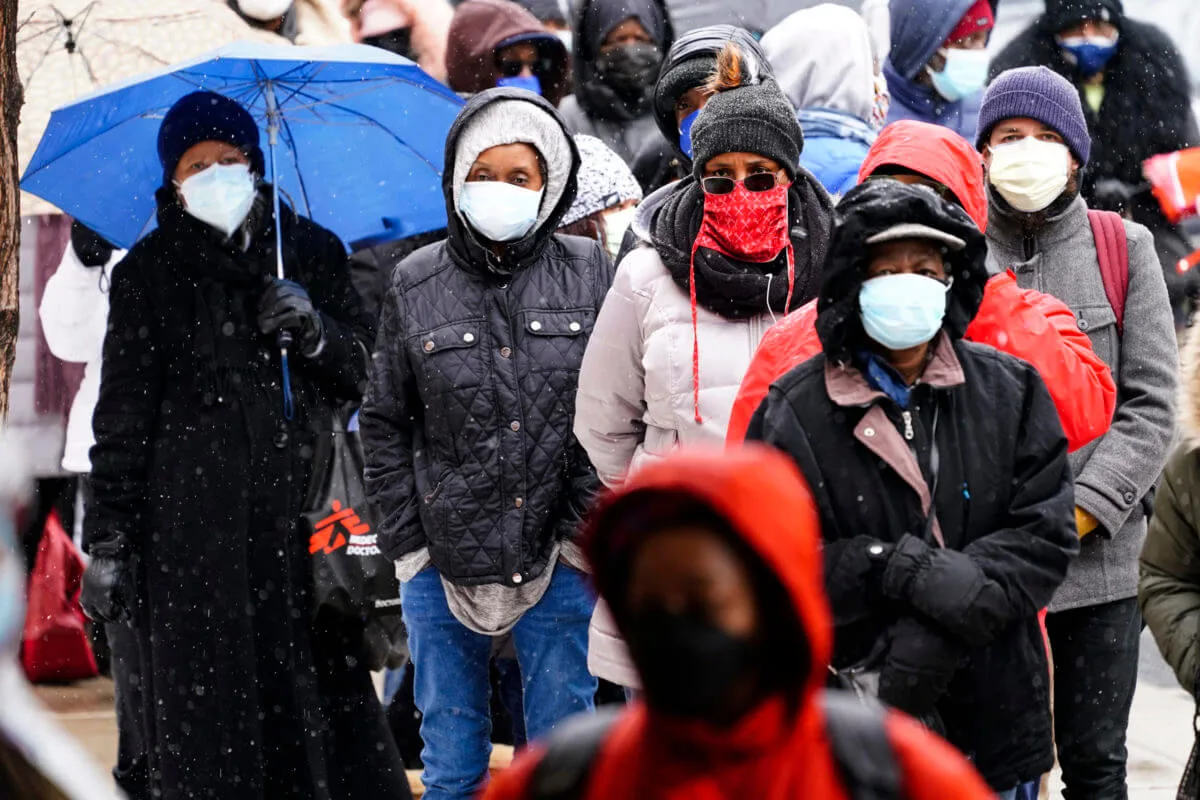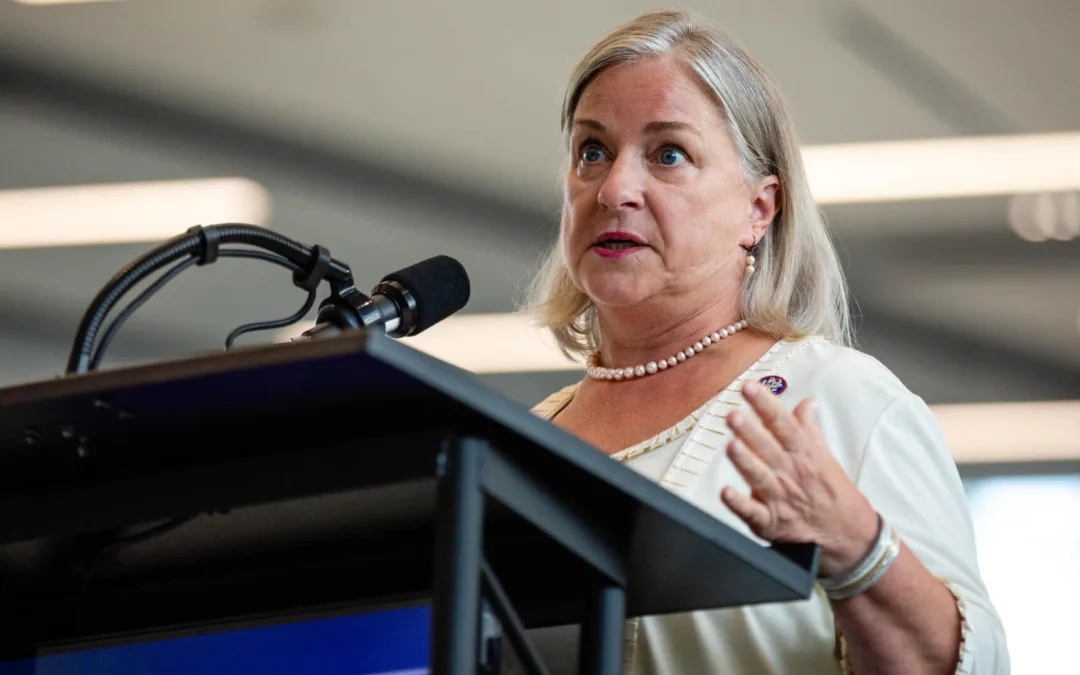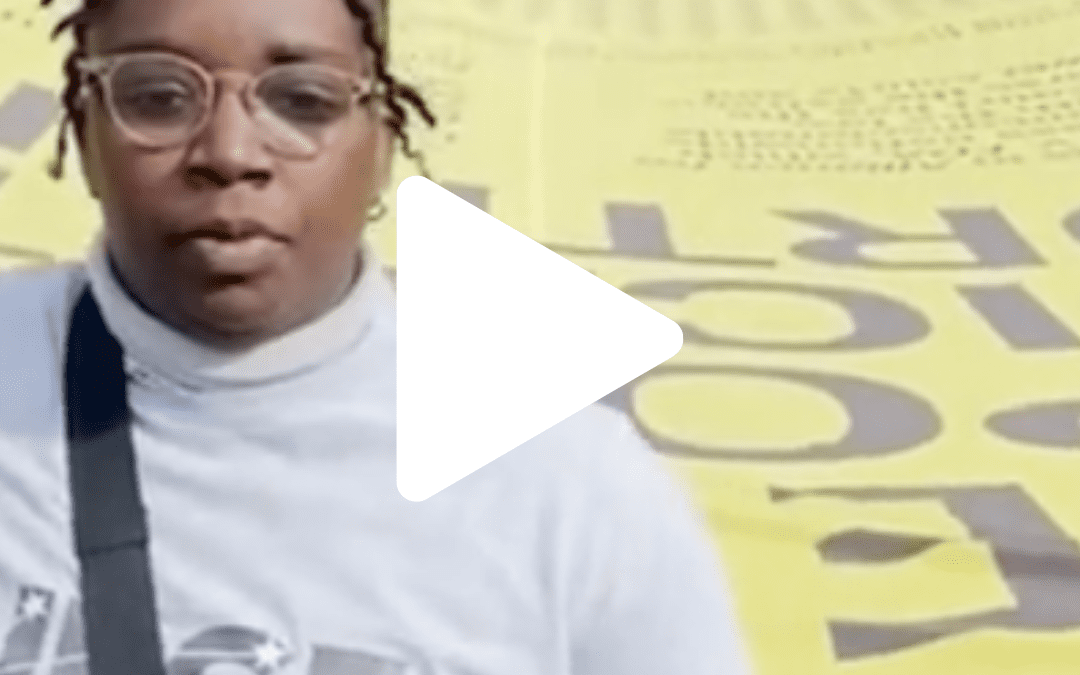
FILE - In this Feb. 19, 2021, file photo, people wait in line at a 24-hour, walk-up COVID-19 vaccination clinic hosted by the Black Doctors COVID-19 Consortium at Temple University's Liacouras Center in Philadelphia. At least for now, U.S. health authorities say after being vaccinated, people should follow the same rules as everybody else about wearing a mask, keeping a 6-foot distance and avoiding crowds even after they’ve gotten their second vaccine dose. (AP Photo/Matt Rourke, File)
The pandemic has been deadliest for Black and Latino communities. These same communities are also least likely to receive vaccines.
Samhia Carroll was teaching in China eight hours away from Wuhan province when the pandemic hit last year. Alarmed, the 40-year-old mom of two returned with her family to the United States as soon as possible. Once home in Philadelphia, despite following precautions and wearing N95 masks everywhere, she contracted COVID-19 from her mother. She also watched friends lose relatives to the illness.
Still, like many Black Americans, Carroll is averse to lining up for the vaccine.
“I need them to have time to test it and make sure there are no kinks,” Carroll said, referring to the seemingly swift federal rollout of the coronavirus vaccine. “Once it’s been around a little longer and they’ve had time to study it, I’d be more inclined to take it.”
The pandemic has been deadliest for Black and Latino communities. These same communities are also least likely to receive vaccines. Systemic barriers to proper health care and underserved communities’ distrust born of unethical and racist treatment are contributing to a complex and deadly storm.
Black Americans are dying from COVID at 1.5 times the rate of white people. Yet, according to the latest data from the Centers for Disease Control and Prevention (CDC), out of all COVID vaccinations administered, only 6.4% of people who’ve received at least one vaccine dose are Black and only 8.7% are Latino. Other populations of color such as Asian (5%) and Indigenous people (1.7%) had low vaccination numbers as well. By contrast, 64% of those who’ve gotten at least one dose so far have been white.
What Is Hampering Vaccination Efforts?
The lack of state-based data isn’t helping. As of early February, only 23 states were collecting information on the race of their vaccine recipients. Factors behind the gaps range from state laws prohibiting the collection of race and ethnicity data to privacy policies that restrict data sharing. Recipients and data collectors are also not filling out forms completely.
“If you want to reach vulnerable populations, and you want to understand who is most vulnerable, it’s a requirement that the government collect data on—at a minimum—age, sex, and race,” Nina Schwalbe, a professor at Columbia University’s Mailman School of Public Health, told Al Jazeera.
RELATED: COVID Vaccine Hesitancy Is a Very Real Concern in Communities of Color. Black Doctors Are Doing Something About It.
“The race and ethnicity data is important because we know who’s bearing the brunt of the pandemic, so there is a fairness and an empathy issue,” Dr. Marcus Plescia, chief medical officer of the Association of State and Territorial Health Officials, told the New York Times. “But there is also a disease-control issue. If those are the groups most likely to get affected and die, those are the groups we need to make sure we are reaching with [the] vaccine.”
A dearth of pharmacies, hospitals, and public transportation options in Black and brown communities has also contributed to the lower rates of vaccinations. A 2019 study by the journal JAMA Internal Medicine showed that one in eight pharmacies closed its doors between 2009 and 2015—mainly smaller, independent drugstores serving uninsured or publicly insured Black and Latino patients. Local pharmacies are proving vital to getting the vaccine into arms. West Virginia’s vaccination program has outstripped most states, despite its rural population, because of its reliance on a strong network of independent pharmacies.
Compounding the issue of accessibility is sheer confusion over where to find a shot. A recent study by the Kaiser Family Foundation found that two-thirds of Black and Latina women don’t know where they can go to get a COVID vaccination.
But along with traditional structural barriers, a deep-seated hesitancy based on racially targeted trauma from the government and medical industry must also be overcome.
As a healthcare worker, Derrick Harrell, a Houston-based traveling nurse, was eligible for the vaccine. Despite that access, he too was reluctant to be first in line.
“I’m adopting a wait and see approach,” said Harrell. “The Tuskegee Experiments went on until the ‘70s. I’m not trying to be the government’s guinea pig.”
The Tuskegee Experiment was a program run by the United States Public Health Service and the CDC to study the long-term effects of untreated syphilis in Black men. From 1932 to 1972, more than 600 Black men seeking treatment in Alabama were deceived with placebo drugs and their symptoms studied until they died. It’s among the most egregious examples of medical racism in US history, but there are many others, contributing to a general atmosphere of distrust from Black American communities toward the medical establishment.
How Is the Biden Administration Working to Overcome Those Barriers?
President Joe Biden publicly stressed the need to prioritize vaccine access to marginalized communities. Shortly after taking office, he signed an executive order creating a task force to address coronavirus-related health and social inequities, tasking Dr. Marcella Nunez-Smith as chair. In 2020, the epidemiologist was appointed the inaugural associate dean of health equity research at the Yale School of Medicine, and later joined the Biden-Harris campaign as an advisor on all things coronavirus.

“This is a national emergency, and we need to treat it like one,” Nunez-Smith said during a virtual event hosted by Choose Healthy Life, a coalition of faith leaders working to combat the pandemic’s impact on Black people, last month. “We need equitable access to testing, treatments, and vaccines.”
Biden’s five-point COVID plan aims to establish vaccination centers and mobile vaccination sites in underserved areas, facilitate partnerships with community health centers, and make sure residents of high-risk facilities such as jails and homeless shelters have vaccine access.
Last week, a new White House initiative to provide 1 million vaccine doses to 21 pharmacy chains—including Walgreens, CVS Health Corp., Costco Wholesale Corp., The Kroger Co., and Rite Aid Corp—began phased implementation. The shots require appointments and are free. Currently, most states are distributing vaccines to healthcare workers, senior citizens, people in residential facilities such as nursing homes, and people under 65 who live with comorbid diseases.
Additionally, FEMA recently opened its first mass vaccination sites, beginning in California, which has seen the highest toll at nearly 50,000 COVID-related deaths. The Biden administration plans to open 100 federally supported vaccination sites nationwide. In the coming weeks, White House press secretary Jen Psaki announced last week, the government would double the number of doses headed to local pharmacies to 2 million.
Vice President Kamala Harris has also been enlisted to ease mistrust amid efforts to beat back the pandemic. As the highest-ranking and most visible person of Black and Asian descent in the administration, Harris has been making the rounds in Black-led media, virtual town halls and other public-facing events. In January, she tweeted video of herself getting vaccinated.
“It was painless, it was simple, it takes seconds and it will save your life. And it’ll save your family’s life,” she wrote.
Medical experts say it will take a concerted effort to meet the challenges of rebuilding trust and ensuring vaccine access for communities of color. Dr. Dan Fagbuyi, an emergency room physician and former Obama administration biodefense and public health advisor, stressed that breaking down the walls would not be a fast process.
“That means acknowledging current and historical misdeeds, presenting what the medical community and federal government are doing to redress these violations of trust, and engaging Black and Brown folks in policy making,” Dr. Fagbuyi told a COURIER panel. “Then finding out the concerns of their local communities, engaging their trusted messengers and meeting people where they are,” instead of requiring them to come to unfamiliar or unwelcoming medical settings.
The picture seems to be slowly improving. About 1.8 million vaccine doses are being administered each day, and about 13% of the US population has received at least one dose. Daily deaths are 2,000 per day on average, down by a third from their peak in January, and new cases have fallen to the lowest point this winter, to about 65,000. But more data is needed to track the pandemic’s most vulnerable populations.
“I just want to be here for my kids,” said Carroll, the teacher. “I don’t want anything to jeopardize that.”

For Rep. Susan Wild, supporting PA families includes reproductive rights and much more
Rep. Susan Wild wants to be very clear with Pennsylvanians: Donald Trump is committed to taking away women’s reproductive freedom, but he is not...

School districts working with anti-LGBTQ groups can cost your kids’ schools millions
Parents across South Central Pennsylvania are worried about the potential financial impacts working with anti-LGBTQ groups may have on their school...

VIDEO: Trump distances himself from his anti-abortion views
Donald Trump appeared on WGAL on Tuesday and continued to distance himself from his anti-abortion views claiming that reproductive rights are now a...

VIDEO: Community pushback gets school board to rescind decision on denying gay actor’s visit
Cumberland Valley School Board offered a public apology and voted to reinstate Maulik Pancholy as a guest speaker a week after the board voted to...

VIDEO: Project 2025 brings nuclear armageddon back into vogue
Project 2025 is a titanic document, with plans ranging from cutting half of all government employees to targeting reproductive rights on a scale...



